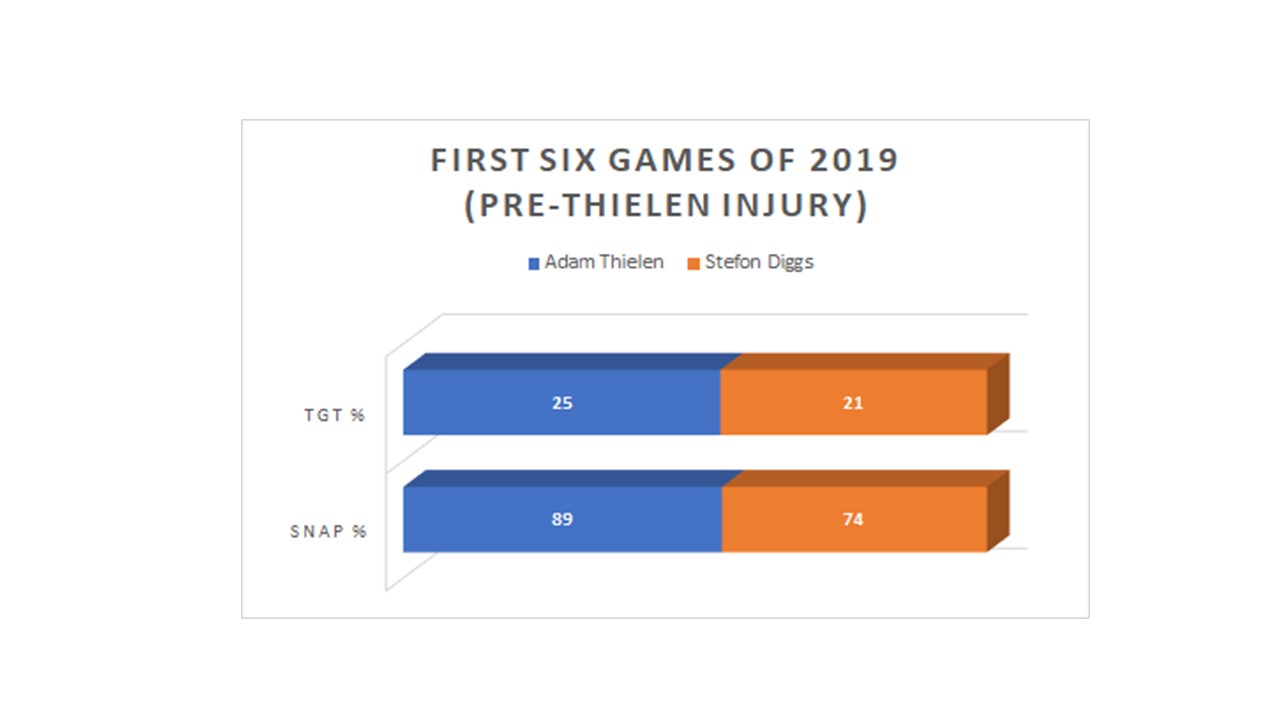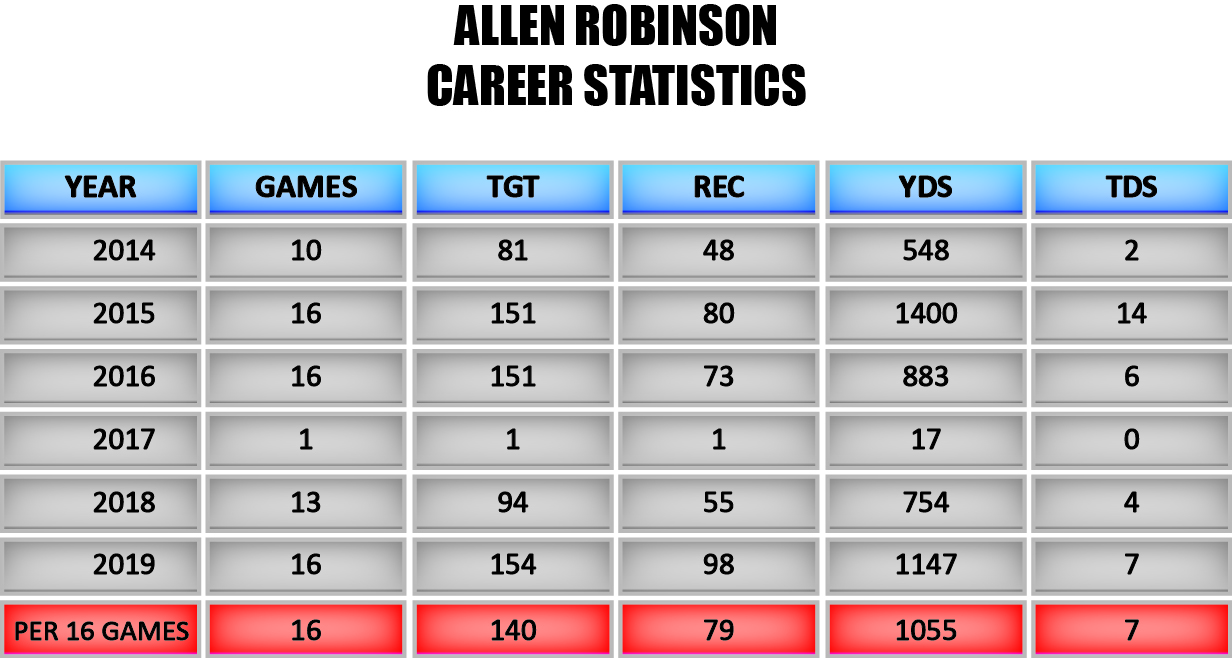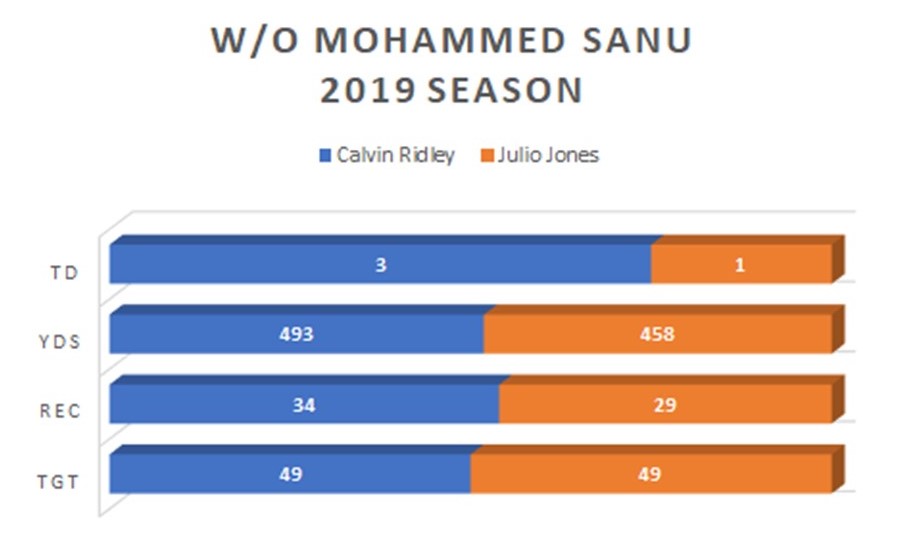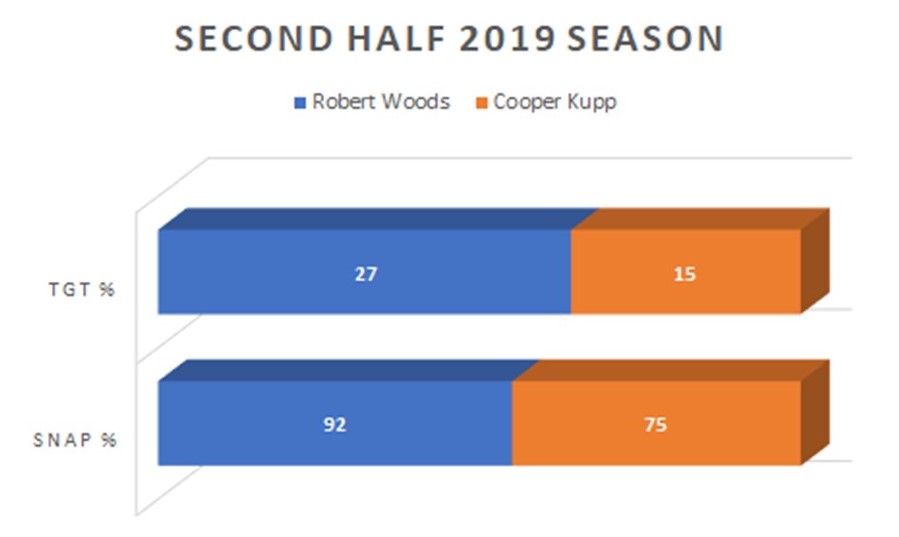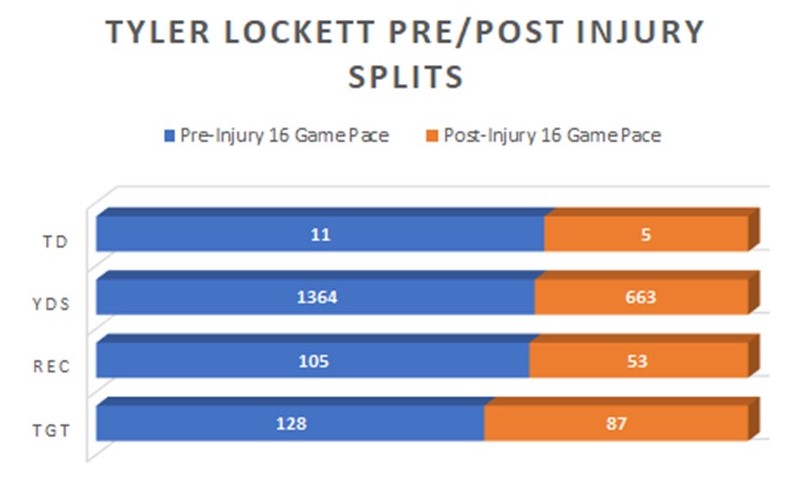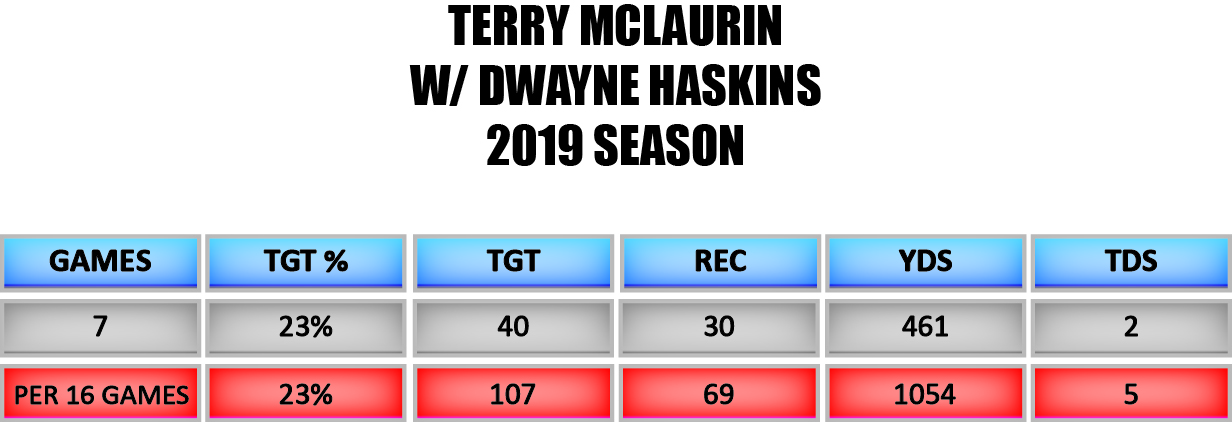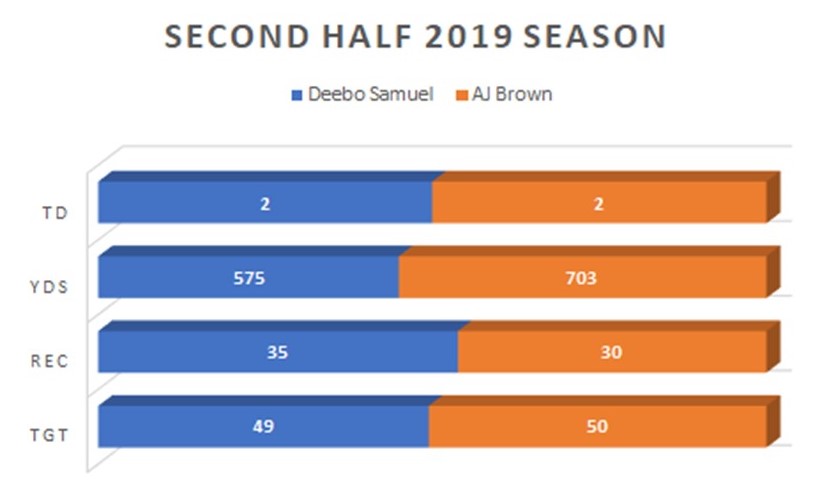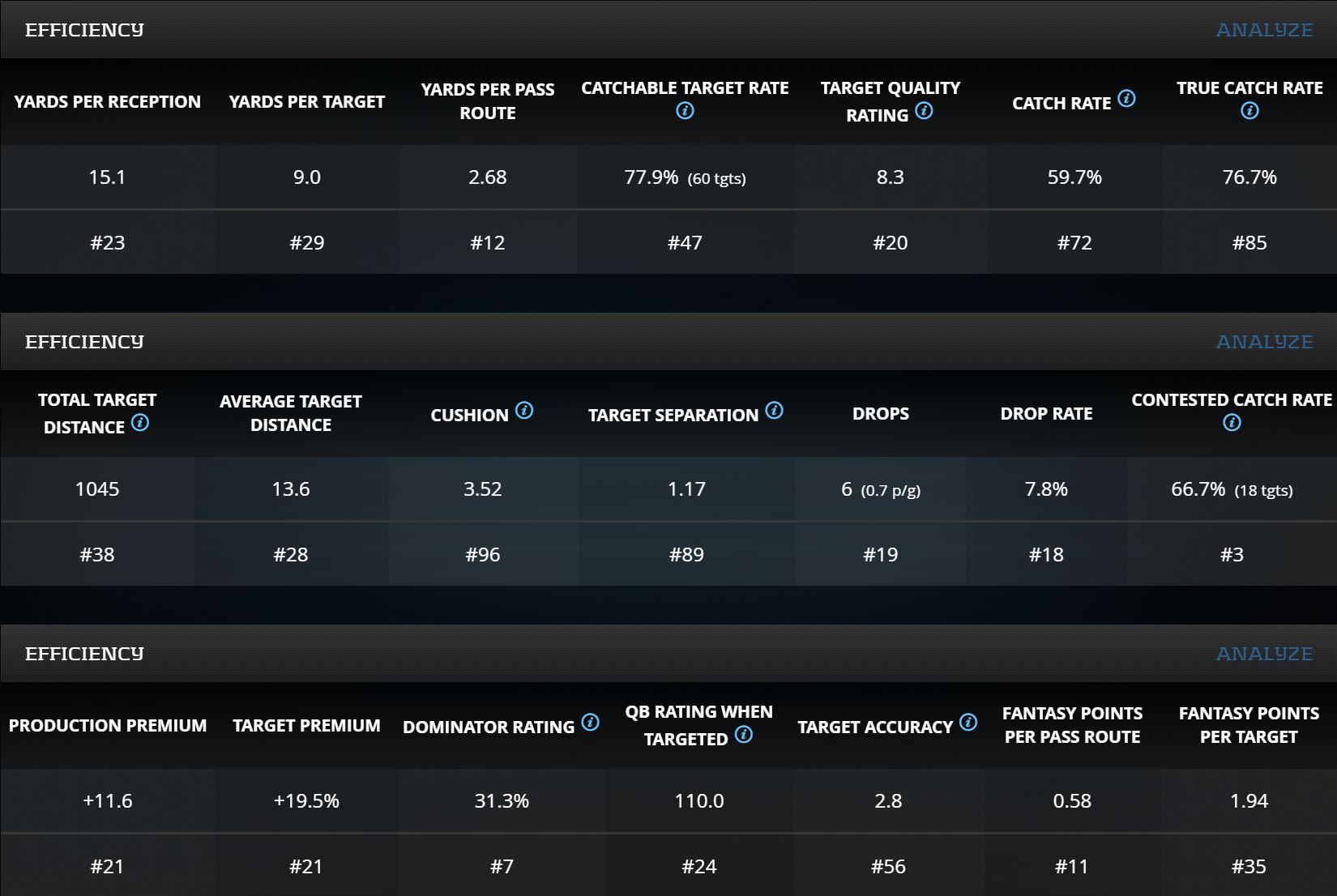Zero RB pundits point to RBBC situations that they can try and take advantage of later in drafts, pairing inexpensive backs and hoping to hit on one. However, the NFL has never used more three wide receiver sets in the history of the sport, leading to some teams taking a WRBC-type approach. With positional scarcity and point differential coming into play, it would behoove fantasy gamers to at least make their two highest investments into the running back position, if not even their top three.
If we take an even closer look at last season’s point totals, we’ll find the dips in production from running back tiers versus wide receiver tiers are much larger. With that said, here are eight wide receivers whose advanced stats & metrics make them players to target for drafters starting RB-RB or RB-RB-RB.
Adam Thielen (FFPF ADP: 49.77)
Adam Thielen is a great story of a player who paid his dues for years before finally breaking out at age 26. While the story is great, this most likely means the fall is on the horizon. However, Thielen has a monster opportunity coming this season. He was already Kirk Cousins’ number one target, but there are no questions who the target king in Minnesota will be with Stefon Diggs being traded.
After two seasons averaging 148 targets for a line of 102-1,324-6.5, Thielen pulled his hamstring in Week 7 last year and basically lost the rest of his season. Still, there are underlying metrics that show he’s still got it. His 1.53 (No. 47 among qualified wide receivers) yards of Average Target Separation was an improvement from 2018, and he finished with 0.58 (No. 6) Fantasy Points per Pass Route and 2.38 (No. 3) Fantasy Points per Target.
While it’s unlikely there is enough team volume for Thielen to reach those gaudy target volumes from 2017 and 2018, he should command at least a 25-percent Target Share while being the primary red zone target. Which projects him to be a top ten fantasy WR in 2020.
Allen Robinson (ADP: 42.42)
Over his last full three full seasons, Allen Robinson has commanded 151, 151, and 154 targets, averaging a stat line of 84-1,143-9 line. His QBs during these seasons were Blake Bortles and Mitchell Trubisky.
Coming off a torn ACL, Robinson had a down year in 2018. He failed to surpass 1,000 yards, only commanding a 21.9-percent (No. 26) Target Share with a 12.7-percent (No. 52) Hog Rate as Chicago’s No. 1 receiver. In 2019, now two years removed from that injury, Robinson came out of camp and the preseason without any ailments. He went on to produce 98 (No. 6) catches for 1,147 (No. 13) yards and seven (No. 13) touchdowns, with Trubisky as his quaterback. He ranked outside the top fifty in all the target accuracy metrics, yet he had a 16.2-percent (No. 13) Hog Rate, 27 (No. 8) Deep Targets, 908 (No. 6) Completed Air Yards, 11 (No. 9) red zone receptions and a 58.3-percent (No. 5) Contested Catch Rate.
Check out Allen Robinson’s 2020 Projection on PlayerProfiler’s “World Famous” Draft Kit:
Robinson was a remarkably consistent, high floor option with Trubisky throwing the ball. The Bears have theoretically brought in Foles as a backup. While he is not a good quarterback by any means, he does present as an upgrade over Trubisky and will be the best QB Robinson will have played with thus far in his career. Even with all the deep targets he saw in 2019, he still averaged only 2.4 yards after catch per reception. It seems he will merely have to improve on his career-low 11.7 (No. 69) yards per reception to outproduce his 2019 season. Foles had no problem launching the ball to Alshon Jefferey in Philadelphia, so he should see no reason to hold back from doing so to Robinson.
With his projected volume, Matt Nagy moving him all over the formation, and Foles under center, a top five fantasy season is in the range of outcomes.
Calvin Ridley (ADP: 46.5)
At 6-1, 190-pounds, Calvin Ridley is not a true prototypical alpha receiver in the NFL. However, with Mohamed Sanu and Austin Hooper out of town in a passing offense that led the NFL in attempts last season, Ridley is primed for a WR1 campaign.
At this stage in their careers, it is fair to wonder who will be the more explosive player next season. For the second time in his career where he has played at least thirteen games, Julio Jones failed to reach 450 yards after the catch. He has now had a three-year decline in; yards per reception, Average Target Distance, and Target Separation while entering his age 31 season.
Taking a closer look at their splits, like most dome teams, the numbers for both receivers on turf exceeded what they were able to do on grass due to a faster playing surface. Is this a sign of things to come for Jones? He caught 70-percent of his season’s yardage on turf, and the difference between his and Ridley’s yardage on grass was only 63 yards. Meanwhile, after the Falcons traded Sanu, Ridley was seeing higher Snap Shares than Jones before getting injured and missing the final three and a half games of the season. While we mentioned Jones’ dip in Average Target Distance, Ridley’s rose by over three yards per target last season.
While this sounds like a piece taking down Jones, it is important to note he is still excellent and projects as a top five WR in fantasy for 2020. However, taking Ridley rounds later allows us to fill those important RB slots early.
Robert Woods (ADP: 54.81)
While everyone keeps looking at Cooper Kupp, Robert Woods is a sneaky pick a few rounds later. Woods led the team in snaps, targets, Target Share, and yards per game. After only scoring three (No. 59) touchdowns last season, positive regression is coming after scoring seven (No. 13) touchdowns in 2018 on similar volume. When the Rams were using 11 personnel, Kupp was the primary target in Weeks 1-8, while Woods had 60 targets for 38-471-0. In the final seven games, the Rams increased their usage of 12 personnel. Kupp’s usage decreased and Woods’ role increased, resulting in 79 targets for a 52-663-2.
The Rams moving to a much higher percentage of two TE sets falls in line with what Sean McVay previously did in Washington with Jordan Reed and Vernon Davis, while also helping a deteriorating offensive line. With Brandin Cooks traded, this shows that McVay intends to continue running two TE sets and solidifies the workloads for both Woods and Kupp. While many will be quick to draft Kupp as a WR1, Woods has the same ceiling with a higher floor.
Tyler Lockett (ADP: 64.23
Tyler Lockett had some real boom weeks in the first half of the season before getting hurt against the 49ers. Lockett lined up in the slot 60-percent of the time, but was not just used short. He had 26 (No. 11) Deep Targets and averaged 1.91 (No. 9) yards of Target Separation. Even at an undersized 5-10, 180-pounds, he had a 27.4-percent (No. 10) Red Zone Target Share and 17 (No. 2) Red Zone Receptions.
Lockett did suffer a serious injury before Seattle’s bye week, which allowed him not to miss any games. He had a serious leg contusion that swelled up and clotted, and he was rushed to the hospital from the football field. This injury clearly affected his play in the back half of the season.
While Lockett is in a possible 1A-1B situation with a more prototypical alpha in D.K. Metcalf, he possesses a rare connection with Russell Wilson. They have completed 77-percent of their targets the last two seasons. Lockett has top 12 fantasy WR upside.
Terry McLaurin (ADP: 65.96)
Many detractors will be worried about taking Terry McLaurin with Dwayne Haskins under center. However, in the seven games that Haskins started last season, McLaurin saw the same volume and sixteen game pace as he did in the first nine weeks.
McLaurin’s is the only unquestioned No. 1 receiver for his team at his ADP. He had a 23.0-percent (No. 22) Target Share, which has room for growth. The only real target competition brought in was Antonio Gibson, currently projecting as an RB/gadget player. Though he didn’t crack 100 targets, a major shift in volume is on the horizon with Scott Turner being brought in as the new offensive coordinator. Washington only ran 885 plays last season. Scott’s father Norv Turner, who is our best comp right now for scheme/pace/volume, only had two seasons in his 28-year career with less than 960 plays called. With the team pumping up the pace and volume, they should throw the ball well over five hundred times in 2020, providing plenty of extra opportunities for McLaurin.
Deebo Samuel (ADP 74.15)
Deebo Samuel is being drafted outside the top twenty wide receivers, while A.J. Brown is being drafted among the top 16, though Samuel experienced a similar second half breakout.
Brown is the better player/prospect, but his yards per reception over that span is unsustainable. To put it into context, the great Randy Moss never finished a season with over 20 yards per reception the way Brown did last season. In 2020 coming off a Super Bowl appearance, the 49ers should experience a more difficult schedule, potentially bumping up the total play volume next season. Samuel was efficient with the opportunities he was given, with 461 (No. 5) yards after the catch, nine (No. 13) red zone receptions, 9.9 (No. 12) yards per target, 0.55 (No. 13) yards per route run, 1.84 (No. 15) yards of Average Target Separation, and 2.31 (No. 5) Fantasy Points per Target. Samuel has the same room for opportunity gain as Brown, making him a bargain almost twenty five picks later.
A.J. Green (ADP: 83)
It has been almost two years since we last saw A.J. Green on a football field, but do not forget the player he was before exiting the 2018 season with toe and ankle injuries. In the half a season he did play, Green had a 17.7-percent (No. 9) Hog Rate, 32.6-percent (No. 5) Red Zone Target Share, 52.0-percent (No. 2) End Zone Target Share, 2.68 (No. 12) Yards per Pass Route, and a 31.3-percent (No. 7) Dominator Rating.
Green is still a WR1, when health permits. He has never had a Target Share under 26-percent. In the six seasons he has played at least thirteen games, he has averaged a stat line of 81-1208-9. The obvious caveats are whether he signs the franchise tender and stays in Cincinnati, along with the fact that he has now missed 29 games in his last four seasons. No wide receiver available this late in drafts offers the kind of upside Green does.
Conclusion
In addition to taking advantage of positional scarcity, do not forget we are simultaneously lowering our opponents baselines/ceilings by limiting their RB pool. Whether in a traditional snake draft or an auction league, investing premium capital on wide receivers is not the winning proposition.
Honorable Mentions: JuJu Smith-Schuster & Diontae Johnson


